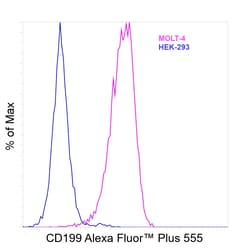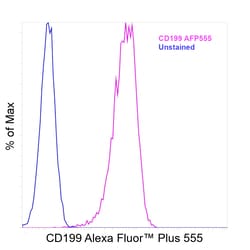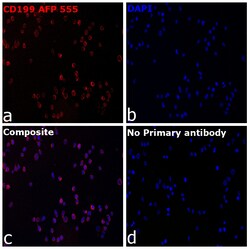Learn More
Invitrogen™ CD199 (CCR9) Recombinant Mouse Monoclonal Antibody (BBC3M4), Alexa Fluor™ Plus 555
Mouse Recombinant Monoclonal Antibody
Supplier: Invitrogen™ 740187MP555XS

Description
Alexa Fluor™ Plus recombinant antibodies are conjugated using new, proprietary dye chemistry so you can generate stunning data. Alexa Fluor™ Plus antibodies represent an advancement in fluorescent conjugate technology. Alexa Fluor™ Plus antibodies provide brighter signal compared to leading Alexa Fluor™ antibodies, providing you with better signal-to-noise for your critical experiments. These antibodies show better specificity and lot-to-lot consistency as these are recombinant antibodies, generated by cloning specific genes for the desired antibodies into an expression vector and expressed in vitro. Using conjugate solutions: Centrifuge the protein conjugate solution briefly in a microcentrifuge before use; add only the supernatant to the experiment. This step will help eliminate any protein aggregates that may have formed during storage, thereby reducing nonspecific background staining. Applications Tested: This BBC3M4 antibody has been tested by flow cytometric analysis of MOLT-4 cells. This can be used at less than or equal to 0.5 μg per test. A test is defined as the amount (μg) of antibody that will stain a cell sample in a final volume of 100 μL. Cell number should be determined empirically but can range from 10^5 to 10^8 cells/test. It is recommended that the antibody be carefully titrated for optimal performance in the assay of interest. Excitation: 553 nm; Emission: 568 nm; Laser: Yellow Laser Filtration: 0.2 μm pos...
The protein encoded by this gene is a member of the beta chemokine receptor family. It is predicted to be a seven transmembrane protein similar to G protein-coupled receptors. Chemokines and their receptors are key regulators of the thymocytes migration and maturation in normal and inflammation conditions. The specific ligand of this receptor is CCL25. It has been found that this gene is differentially expressed by T lymphocytes of small intestine and colon, suggested a role in the thymocytes recruitment and development that may permit functional specialization of immune responses in different segment of the gastrointestinal tract. This gene is mapped to the chemokine receptor gene cluster region. Two alternatively spliced transcript variants have been described.
Specifications
| CD199 (CCR9) | |
| Recombinant Monoclonal | |
| 1.0 mg/mL | |
| Proprietary buffer with 0.008% Bromonitrodioxane, 0.008% Methylisothiazolone; pH 6.8 | |
| P51686 | |
| Ccr9 | |
| Protein A/G | |
| RUO | |
| 10803 | |
| 4°C, store in dark, DO NOT FREEZE! | |
| Liquid |
| Flow Cytometry, Immunocytochemistry | |
| BBC3M4 | |
| Alexa Fluor Plus 555 | |
| Ccr9 | |
| A130091K22Rik; C-C chemokine receptor type 9; C-C CKR-9; C-C motif chemokine receptor 9; CC-CKR-9; Ccr9; CCR-9; CDw199; CDw199 antigen; chemokine (C-C motif) receptor 9; chemokine C-C receptor 10; Cmkbr10; G protein-coupled receptor 28; GPR28; GPR-9-6; G-protein coupled receptor 28 | |
| Mouse | |
| 20 μL | |
| Primary | |
| Human | |
| Antibody | |
| IgG1 κ |
The Fisher Scientific Encompass Program offers items which are not part of our distribution portfolio. These products typically do not have pictures or detailed descriptions. However, we are committed to improving your shopping experience. Please use the form below to provide feedback related to the content on this product.


